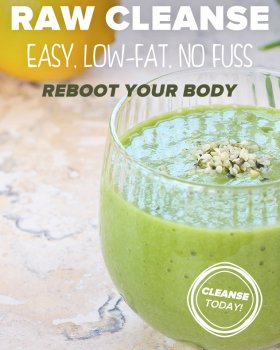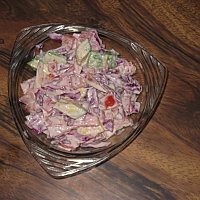If you don't have rejuvelac, you can use regular water instead.
-
Yield
1 cup mayo
Found in:
Ingredients
1/4 cup soaked cashew
1/4 cup soaked macadamias
2 tablespoons lemon juice
2 tablespoons rejuvelac
1/4 cup cold pressed olive oil
1 teaspoon sea salt
1/2 teaspoon agave
Recipe Directions
1. Blend until mixture reaches a mayo-like consistency.
Chef BeLive's Thoughts
 By Chef BeLive
By Chef BeLive If you don't have rejuvelac, you can use regular water instead.
Print This Recipe (PDF)
Click the button below to download the printable PDF.
My Notes
You do not have any notes. Add some here. Notes are private and are only visible to you.
Add New NoteSimilar Recipes
Hello Beautiful!
It looks like you're new to The Rawtarian Community. If you'd like to get involved, click one of these buttons!
Login to Community Signup for an account Login using FacebookCommunity Recipes
Search Recipes
Community Forum
-

Jerusalem Artichoke Syrup (sweetener) -- anyone tried it?
veron - 12 hours 23 min ago -

Edible Weeds.
harrylee - 13 hours 10 min ago -

FAQs re: Points, Leaderboard and Ranks!
Alfredmeikle704 Deleted - 6 days 23 hours ago -

Which dried fruits are excellent in winter for a quick energy boost?
jesse628wallick Deleted - 1 week 1 day ago -

Varicose Veins
Warwithra Deleted - 1 week 2 days ago

































Comments
Top voted
sahara
Jul 04, 2009
What is rejuvilac?? I've never heard of it!
queenfluff
Nov 21, 2010
This is first raw mayo I have actually been happy with the taste of it! Wonderful! I have tried several other and hated the taste. This one turned out nice and thick like heavy SAD mayo. My only chance for myself personally would be to use less macs nuts or maybe sub for pine nuts next time. Maybe a little less lemon too. But otherwise great! thanks for giving me a raw mayo I can love!
Chris S
Apr 24, 2010
Could you possibly dehydrate rejuvilac and make a powder?
All
Chef BeLive
Dec 14, 2011
Glad you enjoyed the mayo
queenfluff
Nov 21, 2010
This is first raw mayo I have actually been happy with the taste of it! Wonderful! I have tried several other and hated the taste. This one turned out nice and thick like heavy SAD mayo. My only chance for myself personally would be to use less macs nuts or maybe sub for pine nuts next time. Maybe a little less lemon too. But otherwise great! thanks for giving me a raw mayo I can love!
Chris S
Apr 24, 2010
Could you possibly dehydrate rejuvilac and make a powder?
haxo
Apr 15, 2010
Rejuvilac is a probiotic. Probiotics are very important for good intestinal health (probiotics are what is in yogurt, the "good" bacteria. So in that sense, Rejuvilac is very important. It is super easy to make once you have done it a few times. Either way, get probiotics any way you can -- in raw sauerkrauts, rejuvilac or even pills.
It is really important to learn about nutrition if you are going to be raw. I recommend going to the Living Light Culinary Institute -- they provide you with all the education and skills you need to be a happy, healthy raw food enthusiast.
smidbrod
Sep 25, 2009
Is rejuvilac worth all the work? I have never made it, but it seems complicated,knowing if it's good, or funky. I have had cheese at raw resturants made with rejuvilac and it was really good, but it's hard to plan what you are eating in a week. What other uses for it are there?
Chef BeLive
Jul 04, 2009
You can make it by taking wheatberries and sprouting them and the soaked water turns into rejuvilac. Here you go..
INGREDIENTS
Makes 2 litres.
* 1 cup of wheat grains, from a health food store.
* 2 litres of water.
* 2 litre mason jar (wide mouthed).
INSTRUCTIONS METHOD 1
1. Add the wheat grains to the mason jar. Fill with water and cover with gauze, held securely in place with an elastic band.
2. Leave the jar on a kitchen bench out of direct sunlight. Give the jar a gentle twirl, but not a shake, every 12 hours. Once a light foam develops the Rejuvelac it should be ready for use. It may take anywhere from 2-5 days to ferment the Rejuvelac depending on the ambient temperature. In hot weather where it may ferment too quickly (around 24 hours) it is possible for the Rejuvelac go putrid. Rejuvelac should have a pleasant yeasty smell with a lemon like flavour.
3. Decant the Rejuvelac into a flagon and refrigerate. Refill the jar with water and ferment for another 24-36 hours to make a second culture. Decant the Rejuvelac and discard the wheat grains.
INSTRUCTIONS METHOD 2
1. Soak the grain over night. Rinse then lay the jar on its side to drain and leave the wheat to sprout for 1-3 days or until the roots are 1-3 mm long. Keep the jar covered with muslin and rinse periodically to prevent the grains from drying out, and to remove harmful organisms.
2. Fill the jar with water and ferment the culture for 1-2 days or until it has gone milky with a layer of froth on the surface.
3. Decant the liquid and refrigerate.
NOTE:
1. It is possible for Rejuvelac to bad (as it is for sprouts and probably any fermented culture). You can generally tell if the rejuvelac is okay by the smell and taste. It should be acidic with a pH less than pH 3.9. It is good practice to observe, smell and taste the rejuvelac periodically to become accustomed to the changes that occur (as it is for any fermented culture). Rejuvelac should keep in the fridge for a week or more, and will gradually sweeten with time.
2. All bacteria and yeasts have an optimum incubation temperature. Refrigeration will inhibit the growth of some organisms but may give an opportunity for others to flourish. Hot weather or high temperatures, may encourage the rapid growth of pathogenic organisms before the beneficial organisms get started, in which case the culture will smell putrid. If your culture goes off, then discard it, sterilise the jar and wait for cooler weather. In hot weather, it is feasible that a slight acidulation of the water with a little lemon juice at the start of the fermentation, may provide an environment less suited to pathogenic organisms.
sahara
Jul 04, 2009
What is rejuvilac?? I've never heard of it!
Leave a Comment